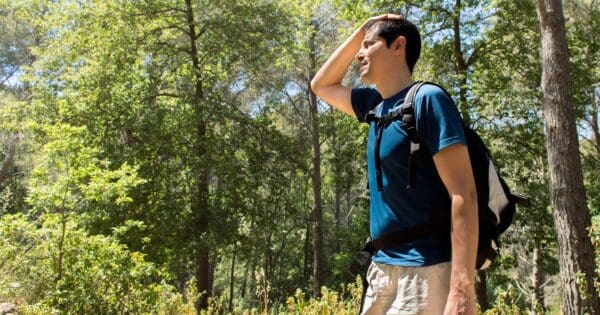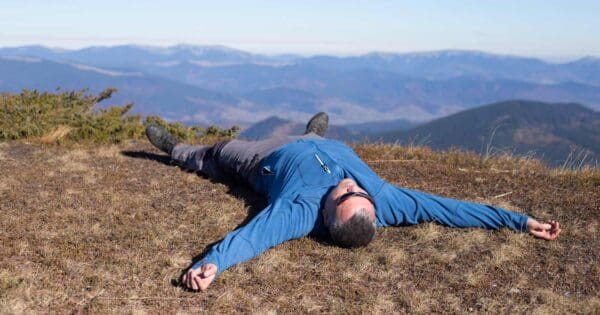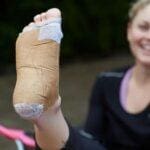Who is at risk?
The flip side to dehydration is overhydration, also known as hyponatremia. This condition is uncommon in hikers but has been documented, particularly during long or strenuous activity where large amounts of plain water are consumed without adequate sodium replacement.
Hyponatremia is most often associated with prolonged exertion, high sweat rates, hot conditions, and excessive fluid intake relative to sodium loss. While it has received media attention, dehydration remains far more common. That said, hikers on long, hot, or physically demanding trips should be aware of the risk and manage fluid and electrolyte intake appropriately.
Overhydration and exercise-associated hyponatremia occur when fluid intake exceeds the body’s ability to excrete excess water and sodium losses are not replaced. When blood sodium levels fall too low, fluid shifts into cells, including brain cells, which can result in serious neurological symptoms.
What is overhydration and hyponatremia?
Overhydration is a fluid imbalance that occurs when the body takes in more water than it can effectively excrete. This excess water dilutes electrolytes in the blood, particularly sodium.
Hyponatremia occurs when the concentration of sodium in the blood becomes abnormally low. Sodium plays a critical role in regulating fluid balance and nerve and muscle function. During hiking, sodium is lost through sweat, and the risk of hyponatremia increases if large volumes of plain water are consumed without replacing these losses.
Risk increases during long-duration hikes, sustained high-intensity activity, hot conditions, and when food or electrolytes are not consumed alongside fluids.
What are the symptoms?
The symptoms of overhydration and hyponatremia are similar to dehydration causing some hikers to mistakenly drink more water and exacerbate the issue.
Symptoms of overhydration
You may not recognise symptoms of overhydration in its early stages. As the condition progresses, common symptoms include:
- nausea and vomiting
- headache
- changes in mental state such as confusion or disorientation
Symptoms of hyponatremia
- Nausea and vomiting
- Headache
- Confusion
- Loss of energy, drowsiness and fatigue
- Restlessness and irritability
- Muscle weakness, spasms or cramps
- Seizures
- Coma
Symptoms of mild to moderate dehydration
- thirsty
- dry mouth, lips and tongue
- headache
- dark urine, and not so much of it
- dizzy or light-headed, particularly when standing up
Symptoms of severe dehydration
- extremely thirsty
- very dry mouth
- breathing fast
- fast heart rate and a low blood pressure
- fever
- little or no urine
- irritable, drowsy or confused
Is overhydration more dangerous than dehydration?
Fatal hyponatremia in hikers is rare, but it has claimed the lives of hikers, and ultra distance runners. Overhydration should be something that all hikers are aware of and take seriously. That being said, it is clear from population data that hyponatremia associated with prolonged hiking is quite rare. It is important to keep the risk of ‘overhydration’ in perspective.
One study of ‘higher risk’ athletes who developed symptomatic hyponatremia were participating in distance running events of 42 km and triathlons lasting 9–12 h. In these events, symptomatic hyponatremia still only occured in 0.1–4% of the participants.
Conversely, dehydration has been estimated to occur in up to 80% of athletes in activities such as team sports, tennis, hiking and endurance events.
How to avoid hyponatremia
Hyponatremia risk increases when fluid intake greatly exceeds fluid and sodium losses. Prevention focuses on balance rather than rigid intake rules.
- Drink according to conditions, exertion, and individual sweat rate rather than forcing fluids
- Include electrolytes or salty foods on longer or hotter hikes
- Avoid excessive intake of plain water without food or electrolytes
- Adjust intake if nausea, bloating, or swelling develops
For most hikers, dehydration remains the more common risk, but electrolyte balance becomes increasingly important as hike duration and heat exposure increase.
How much should you drink?
There is no single volume that applies to all hikers. Fluid needs vary based on temperature, terrain, pack weight, pace, body size, and individual sweat rate.
General sports and exercise guidelines support drinking regularly to limit excessive fluid deficits while avoiding forced or excessive intake. The goal is to replace ongoing losses over time rather than adhering to fixed volumes or schedules.
Monitoring how you feel, adjusting intake based on conditions, and including electrolytes during longer or more demanding hikes provides a practical and safer approach than rigid drinking rules.
Is sipping water OK?
Yes. Sipping water is safe and effective.
Sipping water does not cause dehydration. Dehydration occurs when total fluid intake does not keep pace with fluid losses through sweat and breathing, regardless of whether water is consumed in small or large amounts.
Tragic cases where individuals carried water but became dehydrated reflect insufficient intake, not the act of sipping. Small, frequent drinks while moving or larger drinks at rest breaks are both effective hydration strategies when overall intake matches losses.
The prevention
The key to preventing dehydration and hyponatremia is maintaining fluid and electrolyte balance.
- Carry sufficient water for the conditions and duration
- Drink regularly and adjust intake based on heat, effort, and sweat loss
- Include electrolytes or salty foods on longer or hotter hikes
- Avoid both prolonged under-drinking and excessive forced drinking
Balanced hydration supports physical performance, clear thinking, and safety on the trail.





